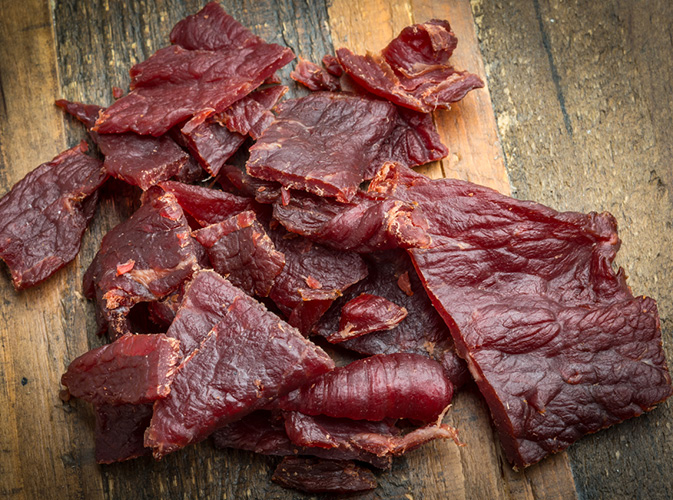Jerky Marinade*
¼ cup soy sauce
1 tablespoon Worcestershire sauce
¼ teaspoon black pepper
¼ teaspoon garlic powder
½ teaspoon onion powder
1 teaspoon hickory smoke-flavored salt
*for 1½ to 2 pounds of lean meat such as beef, pork or venison
Example: Jerky Making Procedures Using Marinade
1. Prefreeze meat to be made into jerky so it will be easier to slice.
2. Cut partially thawed meat into long slices no more than ¼ inch thick. For tender jerky, cut the meat at right angles to long muscles (across the grain). Remove as much visible fat as possible to help prevent off flavors.
3. Prepare 2 to 3 cups of marinade of your choice in a large sauce pan.
4. Bring the marinade to a full rolling boil over medium heat. Add a few meat strips, making sure they are covered by the marinade. Reheat to full boil.
5. Remove pan from range. Using tongs, remove strips from hot marinade (work quickly to prevent overcooking) and place in single, nonoverlapping layers on drying racks. (Repeat steps 4 and 5 until all the meat has been precooked.) Add more marinade if needed.
6. Dry at 140 to 150 F in dehydrator, oven or smoker. Test for doneness by letting a piece cool. When cool, it should crack but not break when bent. The meat should not have any moist or underdone spots.
7. Refrigerate the jerky overnight in plastic freezer bags, then check again for doneness. If necessary, dry further. Soaking the strips in marinade before precooking is not advised because the marinade could become a source of bacteria. Putting unmarinated strips directly into the boiling marinade minimizes a cooked flavor and maintains the safety of the marinade.
Yield: Five pounds of fresh meat should weigh approximately 2 pounds after drying or smoking.
Example: Jerky Making Using a Hot Pickle Cure
1. Slice 4 pounds of meat (¼-inch-thick strips) with the grain. Use lean meat free of fat and connective tissue.
2. Spread out meat and sprinkle on 3 tablespoons salt, 2 teaspoons ground black pepper and 2 tablespoons sugar. Put the meat in a container and refrigerate for 24 hours.
3. Pound the meat on both sides to work in the spices. Optional: Dip strips of meat in a liquid smoke solution (five parts water to one part liquid smoke) for one to two seconds for added flavor.
4. Make a brine by dissolving ¾ cup salt, ½ cup sugar and 2 tablespoons ground black pepper in a gallon of water. Stir to dissolve the salt and sugar.
5. Bring the brine to a low to medium boil (175 F). Immerse the fresh meat strips (a few at a time) into the boiling brine until they turn gray (one to two minutes). Remove meat from the brine, using clean tongs or other utensils that have not contacted raw meat.
6. Spread out meat on a clean dehydrator rack or a clean rack in the top half of a kitchen oven. If you use a kitchen oven, cook the jerky with the door open for approximately one hour at 300 F, and then cook it for at least one hour with the oven door closed to fully cook the meat. Then lower the oven temperature to the lowest possible setting and dry for nine to 24 hours or until the jerky reaches the desired dryness.
7. Remove jerky from oven before it becomes too hard or brittle. Properly dried jerky should crack when bent in half but should not break into two pieces.
8. Store jerky in clean jars or plastic bags, or wrap it in freezer paper and freeze. For best quality, store in a sealed container and use within two weeks. Refrigerate or freeze for long-term storage.



